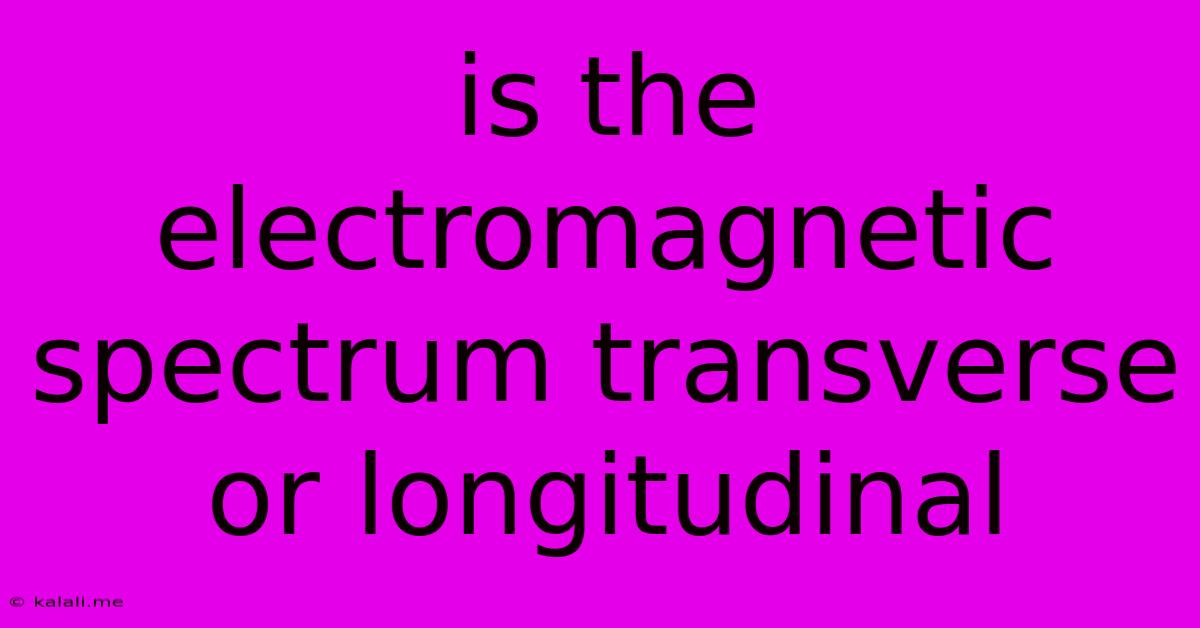Is The Electromagnetic Spectrum Transverse Or Longitudinal
Kalali
Jun 08, 2025 · 3 min read

Table of Contents
Is the Electromagnetic Spectrum Transverse or Longitudinal? Understanding Wave Properties
The electromagnetic (EM) spectrum, encompassing everything from radio waves to gamma rays, is a fundamental concept in physics. A key characteristic defining these waves is their polarization, which directly relates to whether they are transverse or longitudinal. This article will explore this question definitively, clarifying the nature of electromagnetic waves and differentiating them from other types of waves.
What are Transverse and Longitudinal Waves?
Before diving into the nature of electromagnetic waves, let's define the two fundamental wave types:
-
Transverse Waves: In transverse waves, the oscillation of the particles in the medium is perpendicular to the direction of energy propagation. Think of a wave on a string; the string moves up and down (perpendicular) while the wave travels along the string.
-
Longitudinal Waves: In longitudinal waves, the oscillation of the particles is parallel to the direction of energy propagation. Sound waves are a classic example; the air molecules compress and rarefy along the direction the sound travels.
The Nature of Electromagnetic Waves
Electromagnetic waves are unique because they don't require a medium to propagate. Unlike sound waves which need air or water, EM waves can travel through a vacuum (like space). This is a crucial point in understanding their polarization.
Electromagnetic waves are transverse waves. They consist of oscillating electric and magnetic fields that are perpendicular to each other and to the direction of wave propagation. The electric field oscillates in one plane, and the magnetic field oscillates in a perpendicular plane. This perpendicular relationship is the defining characteristic of their transverse nature.
Visualizing the Transverse Nature
Imagine a wave traveling from left to right. The electric field will oscillate up and down, while the magnetic field oscillates in and out of the page (perpendicular to both the direction of propagation and the electric field). This mutual perpendicularity is the key distinguishing feature that confirms EM waves are transverse.
Why not Longitudinal?
The very mechanism of EM wave generation precludes longitudinal polarization. Electromagnetic waves are produced by the acceleration of charged particles. This acceleration creates disturbances in the electric and magnetic fields, which then propagate as waves. The nature of these disturbances, arising from the fundamental laws of electromagnetism, inherently leads to transverse oscillations. There's simply no mechanism for longitudinal oscillations in the electromagnetic field.
Polarization and its Implications
The transverse nature of electromagnetic waves allows for polarization. Polarization refers to the orientation of the electric field oscillation. We can use polarizing filters to selectively block certain orientations of the electric field, effectively filtering the EM wave. This property is exploited in many technologies, including sunglasses and LCD screens. This wouldn't be possible with longitudinal waves.
In Conclusion
The electromagnetic spectrum comprises transverse waves. This fundamental property, stemming from the nature of oscillating electric and magnetic fields, distinguishes them from longitudinal waves and enables phenomena like polarization. Understanding this distinction is key to grasping the fundamental behavior of light and other forms of electromagnetic radiation.
Latest Posts
Latest Posts
-
Convert A Folder With Code Within One File
Jun 08, 2025
-
How To Remove Rust From Fabric
Jun 08, 2025
-
How To Find A Famous Researcher In A Field
Jun 08, 2025
-
Fire Temple Zelda Ocarina Of Time
Jun 08, 2025
-
Can A Sniper Round Penetrate A Tank
Jun 08, 2025
Related Post
Thank you for visiting our website which covers about Is The Electromagnetic Spectrum Transverse Or Longitudinal . We hope the information provided has been useful to you. Feel free to contact us if you have any questions or need further assistance. See you next time and don't miss to bookmark.